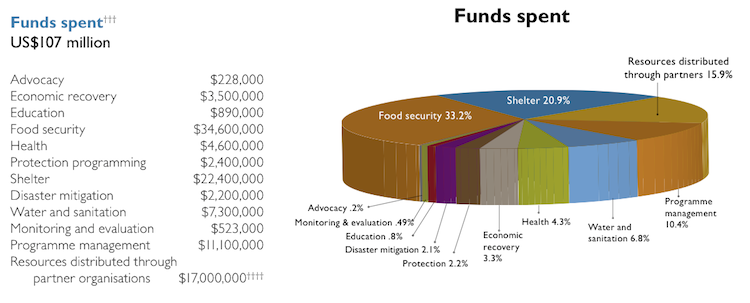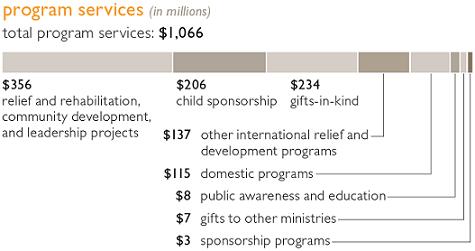World Vision as a disaster relief organization: Haiti Earthquake, 2010 (2011 Report)
Table of Contents
Where we looked
All of the below was examined in November 2010. We also looked for new information in January 2011.
- Responding to Disasters page
- Reports and Publications (PDF)
- Annual Reviews
- Newsroom: ~ 20 updates
- Global Health and Nutrition Annual Report 2008 (PDF)
- Global Hope Initiative: Annual report 2009: Executive summary (PDF)
- World Vision Overview (PDF)
- What we do
- Hope Initiative
- CHARMS summary Dec 2009.pdf (PDF)
- What we do
- Haiti earthquake response: One year later
- Haiti 6-Month Report (PDF)
- Haiti 1-year report (PDF)
- Annual review 2009 (PDF)
How much did the organization raise and how much did it spend?
| Organization | Source | Dates: Jan 12, 2010- | Amount donated | Amount spent |
|---|---|---|---|---|
| World Vision U.S. | Chronicle of Philanthropy1 | Feb 3, 2010 | $22.6 million | N/A |
| World Vision U.S. | Chronicle of Philanthropy2 | Feb 12, 2010 | $24.7 million | N/A |
| World Vision U.S. | Chronicle of Philanthropy 3 | Feb 17, 2010 | $27.6 million | N/A |
| World Vision International | Chronicle of Philanthropy4 | Feb 21, 2010 | $78.5 million ($27.6 million for World Vision U.S.) | $8 million |
| World Vision International | Chronicle of Philanthropy5 | May 7, 2010 | $103 million ($41 million for World Vision U.S.) | N/A |
| World Vision International | 6-month report 6 | July 12, 2010 | N/A | $60 million |
| World Vision International | 1-year Financial Update7 | Sep 30, 2010 | $194 million | $107 million |
How specific is the organization about how it spent its funds?
World Vision reports a break-down of funds spent on each of 12 general categories.8

World Vision also reports numbers of people reached with its activities and a number of other outputs.9
Non-disaster relief activities
- World Vision U.S.'s Annual Review 2009 gives the following breakdown of expenses.10

The most detailed information in the Annual Review 2009 on outcomes is e.g. that in 2009 World Vision taught HIV/AIDS prevention to more than 519,000 people.11
- In the World Vision international annual reviews, World Vision provides highlights on its activities in its four major areas: development, emergency relief, HIV/AIDS, and advocacy.12 The reports are not comprehensive in their descriptions of activities, but instead contain highlights of World Vision programs and a very general break-down of expenses.13
- The World Vision Hope Initiative Annual Report 2009 is not comprehensive but reports highlights such as that in Africa, World Vision provided 102,00 chronically-ill adults with home based care.14
- World Vision's Global Health and Nutrition Annual Report 2008 provides a broad picture of its programs in global health.15
We have not found a comprehensive breakdown of activities or spending on them, at a more detailed level.
Sources
- Chronicle of Philanthropy. $1.1-billion donated for Haiti relief: Updated tally. http://philanthropy.com/article/11-Billion-Donated-for-Haiti/65479/?sid… (accessed September 20, 2010). Archived by WebCite® at http://www.webcitation.org/5ssx7IcOw.
- Chronicle of Philanthropy. American charities raise $774-million for Haiti relief, Chronicle tally finds. http://philanthropy.com/article/American-Charities-Raise/64243/?otd=Y2x… (accessed September 17, 2010). Archived by WebCite® at http://www.webcitation.org/5t63TTO4P.
- Chronicle of Philanthropy. American charities raise $709-million for haiti relief, Chronicle tally finds. http://philanthropy.com/article/American-Charities-Raise/64193/?otd=Y2x… (accessed September 17, 2010). Archived by WebCite® at http://www.webcitation.org/5solB4OOD.
- Chronicle of Philanthropy. Haiti donations exceed $644-million as of February 3. http://philanthropy.com/article/Haiti-Donations-Exceed-644/63887/ (accessed October 3, 2010). Archived by WebCite® at http://www.webcitation.org/5tD60TduA.
- Chronicle of Philanthropy. Haiti recovery: How much charities have raised and spent. http://philanthropy.com/article/Haiti-Recovery-How-Much-Ch/64312/ (accessed January 7, 2010). Archived by WebCite® at http://www.webcitation.org/5vZ5NaHMn.
- World Vision. Annual report 2005 (PDF).
- World Vision. Annual review 2009 (PDF).
- World Vision. Annual reviews. http://www.wvi.org/wvi/wviweb.nsf/webmaindocs/16482B29EAF14ADE8825738D0… (accessed January 7, 2010). Archived by WebCite® at http://www.webcitation.org/5vZYAZUYN.
- World Vision. CHARMS summary Dec 2009 (PDF).
- World Vision. Global Hope Initiative: Annual report 2009: Executive summary (PDF).
- World Vision. Haiti financial update: 1 year later. http://www.worldvision.org/content.nsf/about/20101209-haiti-financial-u… (accessed January 6, 2010). Archived by WebCite® at http://www.webcitation.org/5vXU2gdLu.
- World Vision. Haiti: Blog - John Kisimir http://www.wvi.org/wvi/wviweb.nsf/updates/89A25D8F507B21B1882576D400631… (accessed November 10, 2010). Archived by WebCite® at http://www.webcitation.org/5u8u6X00m.
- World Vision.Child health now: Together we can end preventable deaths (PDF).
- World Vision. Global health and nutrition annual report 2008 (PDF).
- World Vision. Haiti earthquake response: One year on (PDF).
- World Vision. Haiti 6-month report. (PDF)
- World Vision. Haiti: As hurricane season approaches, World Vision concerned storms could create 'secondary disaster' http://www.wvi.org/wvi/wviweb.nsf/updates/0EC23DC2795633C4882577270067B… (accessed November 10, 2010). Archived by WebCite® at http://www.webcitation.org/5u8vhW5mA.
- World Vision. Haiti: Child-friendly space provides some normalcy. http://www.wvi.org/wvi/wviweb.nsf/updates/7ECB5201B5EFBA4A882576C200072… (accessed November 10, 2010). Archived by WebCite® at http://www.webcitation.org/5u8u93ENd.
- World Vision. Haiti: Making life bearable. http://www.wvi.org/wvi/wviweb.nsf/updates/EB3C0AAAB4070B81882576B400717… (accessed November 10, 2010). Archived by WebCite® at http://www.webcitation.org/5u8uBSjit.
- World Vision. Haiti: Six months later - The life of one child. http://www.wvi.org/wvi/wviweb.nsf/updates/D7D5EE0C12EBCE548825775800610… (accessed November 10, 2010). Archived by WebCite® at http://www.webcitation.org/5u8u0AZoC.
- World Vision. Haiti: Vulnerable must be first in line. http://www.wvi.org/wvi/wviweb.nsf/updates/773AFCA4D42EDA6D882576BD006CD… (accessed November 10, 2010). Archived by WebCite® at http://www.webcitation.org/5u8weDZ9A.
- World Vision. Haiti: World Vision distributes emergency health supplies, focuses on preventative measures. http://www.wvi.org/wvi/wviweb.nsf/updates/D6B3096B093D07F4882577C700648… (accessed November 10, 2010). Archived by WebCite® at http://www.webcitation.org/5u8vCi0XG.
- World Vision. Haiti: World Vision provides aid to around 1.8 million people. http://www.wvi.org/wvi/wviweb.nsf/updates/B5E8DE689CD41ABE882577040008C… (accessed November 10, 2010). Archived by WebCite® at http://www.webcitation.org/5u8vq3gwl.
- World Vision. Haiti: World Vision says much has been done but road to recovery will take years http://www.wvi.org/wvi/wviweb.nsf/updates/BD33F364B90D9FF88825775E00122… (accessed November 10, 2010). Archived by WebCite® at http://www.webcitation.org/5u8vae8TG.
- World Vision. Haiti earthquake response: One year later (PDF). http://www.worldvision.org/content.nsf/learn/haiti-relief?OpenDocument&… (accessed January 12, 2011). Archived by WebCite® at http://www.webcitation.org/5vh7NPwLJ.
- World Vision. Hope Initiative. http://www.wvi.org/wvi/wviweb.nsf/maindocs/052F3121CB381D7E8825753C0079… (accessed January 11, 2011). Archived by WebCite® at http://www.webcitation.org/5vfMUIzuz.
- World Vision. Newsroom. http://www.wvi.org/wvi/wviweb.nsf/maindocs/226C8B2D88F716F688257387007E… (accessed January 11, 2011). Archived by WebCite® at http://www.webcitation.org/5vfM3laKz.
- World Vision. Planet prepare: Preparing coastal communities in Asia for future catastrophes http://wvasiapacific.org/latest/the-world-is-changing-planet-prepare.ht… (accessed November 10, 2010). Archived by WebCite® at http://www.webcitation.org/5u9On0ReB.
- World Vision. Reports and publications (PDF).
- World Vision. Responding to Disasters. http://www.wvi.org/wvi/wviweb.nsf/section/DC63CF15990F2E808825737F007E3… (accessed January 11, 2011). Archived by WebCite® at http://www.webcitation.org/5vfLnzNAB.
- World Vision. Serving and helping the poor in nearly 100 countries (PDF).
- World Vision. What we do. http://www.wvi.org/wvi/wviweb.nsf/maindocs/018080C3FFC683ED88257387007D… (accessed January 11, 2011). Archived by WebCite® at http://www.webcitation.org/5vfMLm8Vg.
- World Vision. World Vision Overview (PDF).
- World Vision. World Vision U.S. Site. www.worldvision.org (accessed January 11, 2011). Archived by WebCite® at http://www.webcitation.org/5vfMbPjwF.
- 1Chronicle of Philanthropy, “Haiti Donations Exceed $644-Million, as of February 3 “
- 2Chronicle of Philanthropy, “American Charities Raise $709-Million for Haiti Relief, Chronicle Tally Finds”
- 3 Chronicle of Philanthropy, “American Charities Raise $774-Million for Haiti Relief, Chronicle Tally Finds”
- 4Chronicle of Philanthropy, “Haiti Recovery: How Much Charities Have Raised and Spent”
- 5Chronicle of Philanthropy, “$1.1-Billion Donated for Haiti Relief: Updated Tally”
- 6World Vision, “6-month report,” Pg 7.
- 7World Vision, "Haiti Financial Update: 1 year later."
- 8
World Vision, “Haiti earthquake response: One year on,” Pg 31.
- 9
"World Vision key accomplishments:
- 350,448 people received urgently needed household supplies such as toilet paper, soap and toothpaste, cooking supplies, bed sheets, blankets, buckets, mosquito nets, foot lockers and mats.
- 229,763 households received food aid in the first three months of the response.
- 70,938 children in 454 schools benefited from school feeding programmes between August and October.
- More than 180 feeding centres provided food to 49,200 children not in school.
- 132,153 people were provided with 189.6 million litres of drinkable water.
- 5,653 children registered to play, sing, dance and draw in one of 22 Child-Friendly Spaces.
- More than 1,150 young children ages 3 through 8 attend one of 15 Early Childhood Development Learning Spaces that provide community-based learning.
- 113,409 tarpaulins and 7,497 tents were provided to families in need.
- Transitional shelters were provided for an initial 620 families.
- More than 14,770 people participated in cash-for-work programmes.
- 1,988 people participated in cash-for-training programmes, learning skills such as gardening techniques, masonry and carpentry.
- Five fixed and four mobile health clinics served 11 camps in Port-au- Prince and two mobile clinics served three camps at the border."
World Vision, "Haiti earthquake response: One year on," Pg 3.
- 10
World Vision, "Annual review 2009," Pg 2. (From World Vision U.S. Site, www.worldvision.org.)
- 11
"In 2009, World Vision ... Taught HIV and AIDS prevention
education stressing abstinence to more than 519,000”
young people living in AIDS-affected areas." World Vision, "Annual review 2009," Pg 1. - 12
World Vision, "Annual Reviews."
- 13
World Vision, "Annual Reviews."
- 14
World Vision. "Global Hope Initiative: Annual Report 2009: Executive Summary, " Pg 3.
- 15
World Vision, “Global Health and Nutrition Annual Report 2008."
